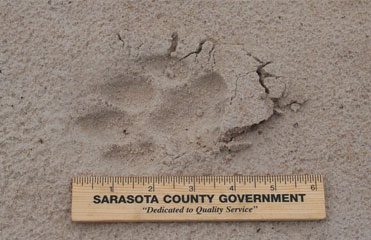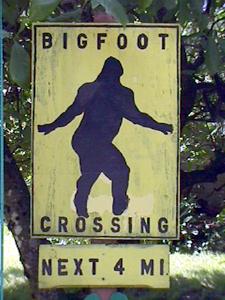Sightings: Wayward Panther, Wolves, and Windigo
Posted by: Loren Coleman on February 19th, 2010
I am following a variety of developing stories.

There are sightings of a Florida panther (track above) very much out of its range being seen around Sarasota, Florida.
Meanwhile, an escaped Mexican wolf is safely back in captivity in Minnesota.
Elsewhere, on the wolf front, Cryptomundo correspondent Peder Knudsen writes in with news of sightings of a wolf in Denmark. (Yes, please, no jokes about “Peder and the wolf.”)
Knudsen writes: “One witness saw it on Sunday [Feb. 14, 2010] in Jels in Haderslev Sønderjylland and another witness saw it on Monday [Feb. 15, 2010] also in Sønderjylland. Three people saw one last year in Voins; a family from Øster Sottrup heard a howl in the night at 4 o’clock. Next morning they found tracks.”
Over 20 people, as of the 17th, reportedly have seen the wolf in Denmark.
It has been almost 200 years since the last wolf was shot there in 1813.
Meanwhile, in New England, word has reached me that that a Windigo (an Eastern Bigfoot) road crossing sighting occurred during the second week of February.

Tracks appear to have been found. For fear of ridicule, the eyewitnesses wish to take a low-key approach. I am following up on this report and will get back to you with details after some further investigations occur over the next few days.
About Loren Coleman
Loren Coleman is one of the world’s leading cryptozoologists, some say “the” leading living cryptozoologist. Certainly, he is acknowledged as the current living American researcher and writer who has most popularized cryptozoology in the late 20th and early 21st centuries.
Starting his fieldwork and investigations in 1960, after traveling and trekking extensively in pursuit of cryptozoological mysteries, Coleman began writing to share his experiences in 1969. An honorary member of Ivan T. Sanderson’s Society for the Investigation of the Unexplained in the 1970s, Coleman has been bestowed with similar honorary memberships of the North Idaho College Cryptozoology Club in 1983, and in subsequent years, that of the British Columbia Scientific Cryptozoology Club, CryptoSafari International, and other international organizations. He was also a Life Member and Benefactor of the International Society of Cryptozoology (now-defunct).
Loren Coleman’s daily blog, as a member of the Cryptomundo Team, served as an ongoing avenue of communication for the ever-growing body of cryptozoo news from 2005 through 2013. He returned as an infrequent contributor beginning Halloween week of 2015.
Coleman is the founder in 2003, and current director of the International Cryptozoology Museum in Portland, Maine.










That track looks much more like that of a canid than a felid.
I wonder why people started calling Eastern Bigfoot a wendigo (aka wittigo/windigo/etc)? Wendigo are entirely different beings, namely, human beings who went insane in the north woods and became cannibalistic beings.
You guys might want to check out this link to a sign from the National Park Service. I found it quite informative. LOL!
Track has been identified by Florida wildlife authorities as felid, comparative to the southern Florida panthers.
There are no claw marks in the imprint, as you would see in a dog, and this does seem to be like a cat running.
As to your other point, Lance, I trust you won’t take offense to the fact that I consider a primary source of Wikipedia hardly a great way to start marking your argument.
What we have going on here is that the precursor tales of the Windigo ~ as a hairy, bipedal primate seen in the forests ~ were there first and then the psychologists and psychiatrists used the model of the Windigo to talk about the windigo psychosis or wittiko psychosis. Of course, this psychosis is real, no doubt, but it is a tale of Western psychology retro-fitting the creatures.
The “monsters of the woods,” the Windigo/Wendigo/Wittiko, were seen first, even if the “insanity” explanation may have been used by some First Peoples. Nevertheless, the sightings of Eastern Sasquatch/Bigfoot were there first. The two topics are actually separate but equal.
The Windigo (also known as the Wendigo, Windago, Windiga, Wittiko, Wihtikow, and numerous other variants) is an unknown hairy hominid tied to the sightings, legends and folklore of First Nations people linked by the Algonquin languages. The Windigo is a bipedal hairy creature, equal to the Eastern Bigfoot, Stone Giant, or Marked Hominid in some classification systems, which is often said to have more aggressive behaviors than its western cousins. The “windigo psychosis” has nothing to do with cryptozoology, except that a name is used for a mental disorder based on the hairy hominids.
Interesting that the sign site notes this:
“He agreed to give us an artist’s rendering of the warning, so we could beat Cryptomundo to the punch by sharing it with you first.”
Humm, hominological and cryptozoological competition? Say it ain’t so, Joe.
And how about this cougar sighting developing in Virginia.
Sounds like they know what they’re seeing.
Now here’s something for Loren’s “name game.”
Checked-out DWA’s link and noticed that right smack-dab in the middle of the three sightings is the town of Exmore, VA. It immediately called to mind “the Beast of Exmoor” another large, out of place felid, across the pond. Coincidence… 😕
There’s more name game stuff than that: Melfa is up the road from Painter, which is an old word for “panther” and north of town is the rather oddly named Bullbeggar Creek and the town of Bullbeggar (bullbeggar is an English hobgoblin appearing in the form of the infamous black dog). I think there may be more to these than “cougar”…
To add a comment to my last bit, also note that Bullbeggar Creek is just over the border from Maryland; and the southern marshes of the Eastern Shore of Maryland have extensive wildman/Bigfoot traditions.
I’ve heard a lot of wendigo stories from Glacier National Park (spaced out in Montana and Canada), always thought they were a northern creature, ie the great white north.
Jmonkey I almost fell for the “sign” gag until I read the last line about small bells in the feces.
Point taken, Loren. I didn’t see any claw marks but the toes seemed so pointed. I guess running would account for that. Here’s a good page on felid vs canid tracks (not Wikipedia :-/ )
As far as the other part goes, well, we’ll leave it as a difference of opinion; I don’t argue with a man in his own house 🙂
The Lenape of the East coast spoke of a forest spirit called the Mesingwa which translates roughly to “living solid face”. The Mesingwa was a a large hairy creature who at times was said to ride a large buck. He was both the boogie man to Lenape children and a benefactor of the tribe. It was said that he taught the tribe how to hunt. Each year at a festival a bear was hunted killed and feasted upon in homage to the Mesingwa. I think he may be our Eastern Sas.
An image of the Mesingwa mask.